It’s no secret that Japanese cherry blossom trees are some of the most beautiful in the world.
With their delicate pink petals and sweet fragrance, they’re a favorite among gardeners and homeowners alike.

But what if you want the beauty of a Japanese cherry blossom tree, but don’t have the space or time to care for one?
Luckily – There are a few different kinds of trees that look just like Japanese cherry blossoms that are much more low-maintenance.
Japanese Cherry Tree
What is so appealing about the Japanese Cherry tree?
People are drawn to the flowers, but the leaves and the tree size are also pretty big factors when deciding you want a Japanese cherry tree.
The Flowers
The flowers of the Japanese cherry tree are relatively small, open, and pink.
Each flower has five petals, which doesn’t sound significant, but they grow in clusters of five or six and can reach up to eight inches in diameter.

The Leaves
Part of the appeal of the Japanese cherry tree is the flowers take over and you don’t tend to notice the leaves at all.
If you do happen to get close to a Japanese cherry tree, you’ll notice that the leaves of the tree are oval-shaped and grow in pairs.
They’re a dark green color and have a smooth texture. The leaves are about four inches long and two inches wide and have a pointed tip.
Pretty standard for a leaf, but this shape is elegant and enhances the tree’s beauty.
The Size
One of the reasons people love Japanese cherry trees is that they don’t get too big.
They typically only grow to be about 20-30 feet tall and 15-25 feet wide.
This makes them the perfect size for a backyard or even as an indoor potted plant.
1. Magnolia Trees
Magnolia trees are one of the best substitutes for Japanese cherry blossom trees.
They have beautiful flowers with long petals. The base of the flower is a deep pink color, but the tips are white.
From a Distance – It gives off the illusion of the same pale pink as a Japanese cherry tree.
Magnolia trees do the best in USDA zones 5-9. Magnolia trees need full sun to partial shade and regular watering but don’t require a lot of fertilizer.
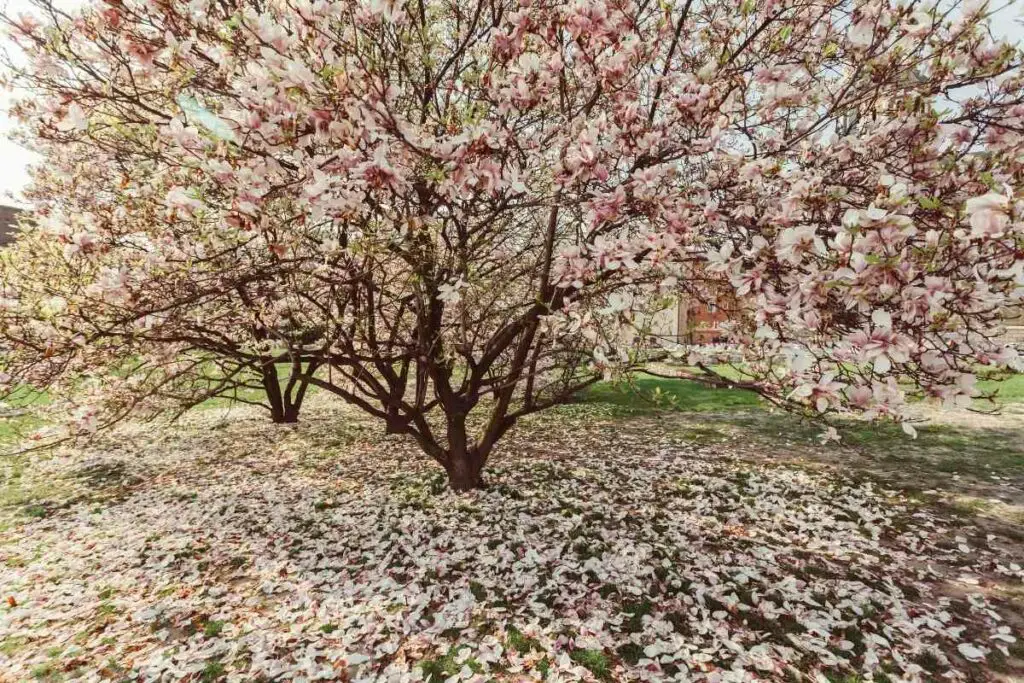
Applying a slow-release fertilizer in the spring when the buds start to appear is more than enough for a magnolia tree.
These trees can grow up to 80 feet tall and up to 40 feet wide, so make sure you have plenty of space in your yard.
The branches constantly drop leaves and petals. You can either choose to prune the bottom branches to be able to mow the leaves and petals, or you can leave them to hide the piles.
2. Ornamental Peach Trees
Ornamental peach trees are another great substitution for Japanese cherry blossom trees.
The flowers are more similar in shape to magnolia tree flowers, but they are still white near the tips and pink towards the base of the flower.
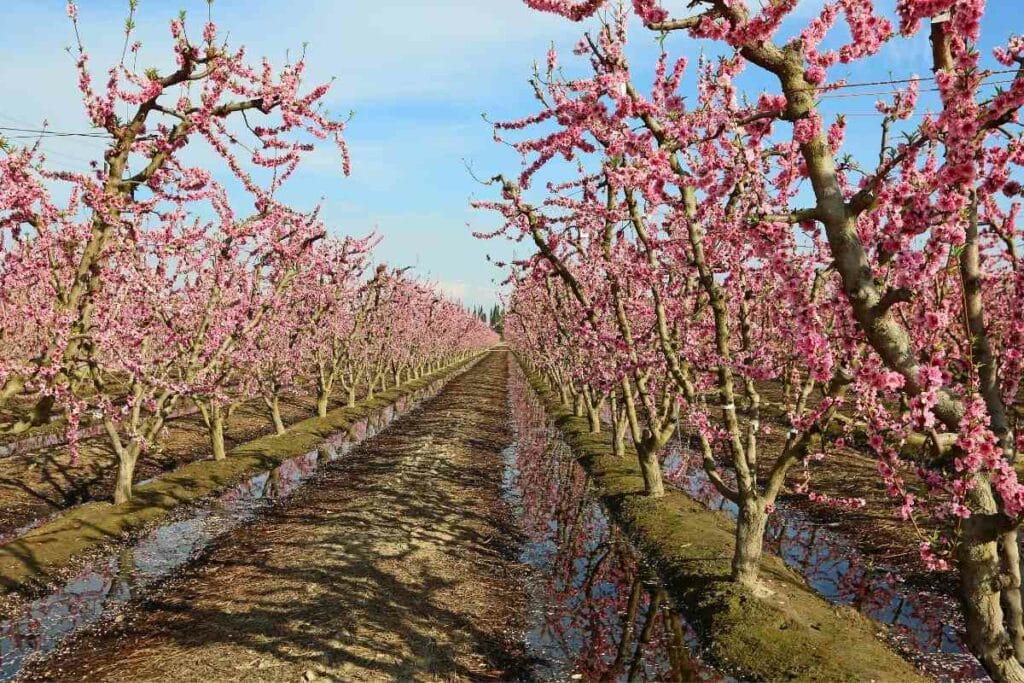
The flowers of an ornamental peach tree don’t form in clusters as Japanese cherry trees do either. Instead, they grow along the branches in a more random pattern.
Ornamental peach trees do best in USDA zones 4-8 and need full sun. They require regular watering but don’t need much fertilizer.
Like Magnolia Trees – Applying a slow-release fertilizer once in the spring should be more than enough.
3. Ornamental Plum Trees
Ornamental plum trees come in a multitude of colors from deep purples, to white, and light pinks.
When looking at the flowers of ornamental plum trees, they are nearly identical to the flowers of Japanese cherry trees and ordinary passersby wouldn’t be able to see the difference between the two trees.
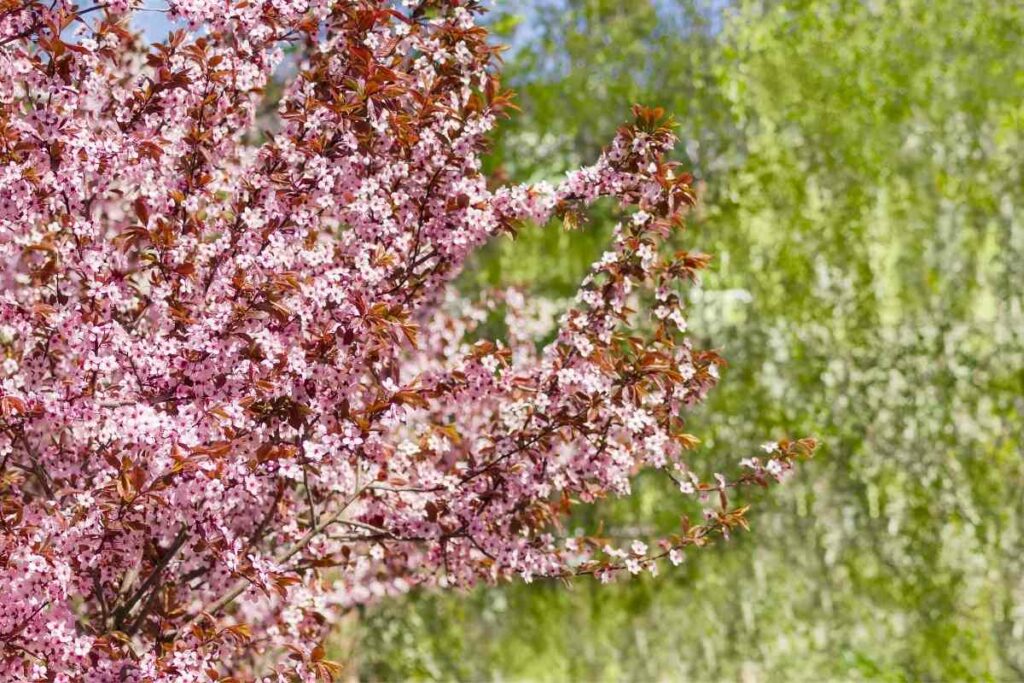
If you’re an avid gardener, you’d notice a few differences right away:
- Firstly, the flowers of the ornamental plum tree grow in very dense clusters, much denser than Japanese cherry trees.
- There are also deep purple leaves that sprout out on stems between the flowers on the plum trees which the cherry trees don’t have.
Ornamental plum trees grow best in USDA zones 5-8.
They love basking in full sun and need frequent watering with well-draining soil; you want to keep them moist but you don’t want the roots sitting in water.
4. Crab Apple Trees
Crab apple trees are the ornamental version of an apple tree.
Fruits from ornamental trees aren’t usually meant to be eaten and are often a very bitter version of what the fruit is supposed to taste like, but crab apples are an exception.
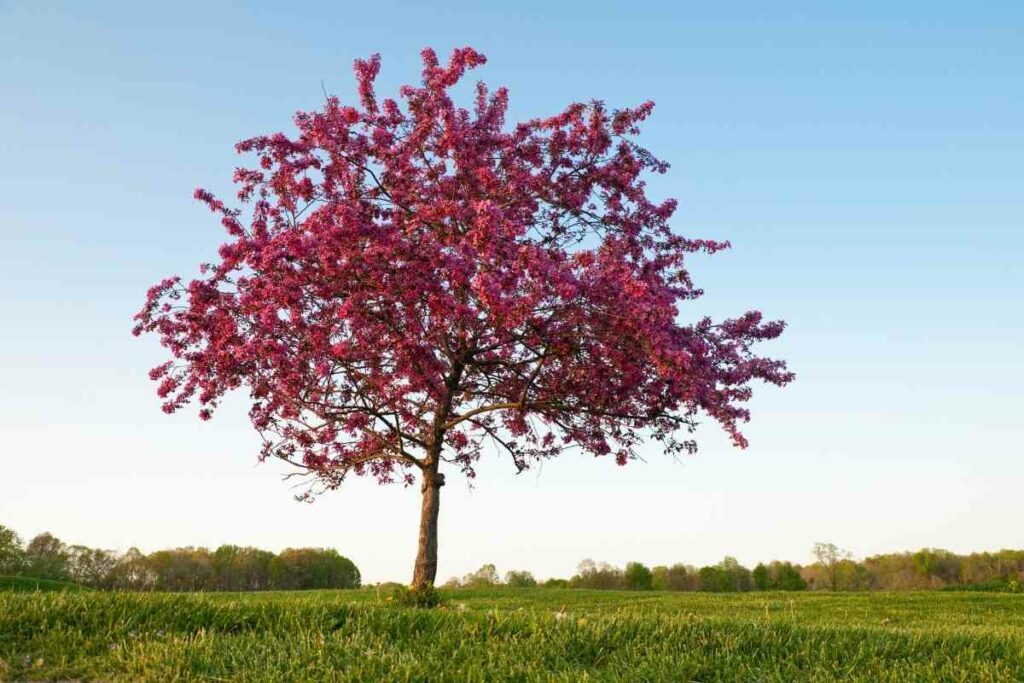
Instead of bitter, most types of crab apples are a blend of sweet and sour which makes them a great snack, or a base for a jam or jelly.
As for the Flowers – They look very similar to Japanese cherry blossoms. They have the same shape, and color and grow in clusters along the branches.
Depending on the type of crab apple tree, you can expect white flowers, light pink flowers, or even magenta flowers.
The best thing about crab apple trees is that they are one of the hardiest types of trees.
They can survive in nearly any type of soil as long as it drains well and they do best in full sun.
Crab apple trees are also very drought tolerant which makes them a great tree to plant if you live in an area with little rainfall.
5. Apple Trees
This is the only non-ornamental fruit tree to make this list, and only because they resemble the Japanese cherry tree so closely that it deserves a spot on this list.
Apple trees have the same amount of petals on the flowers that Japanese cherry blossoms have.
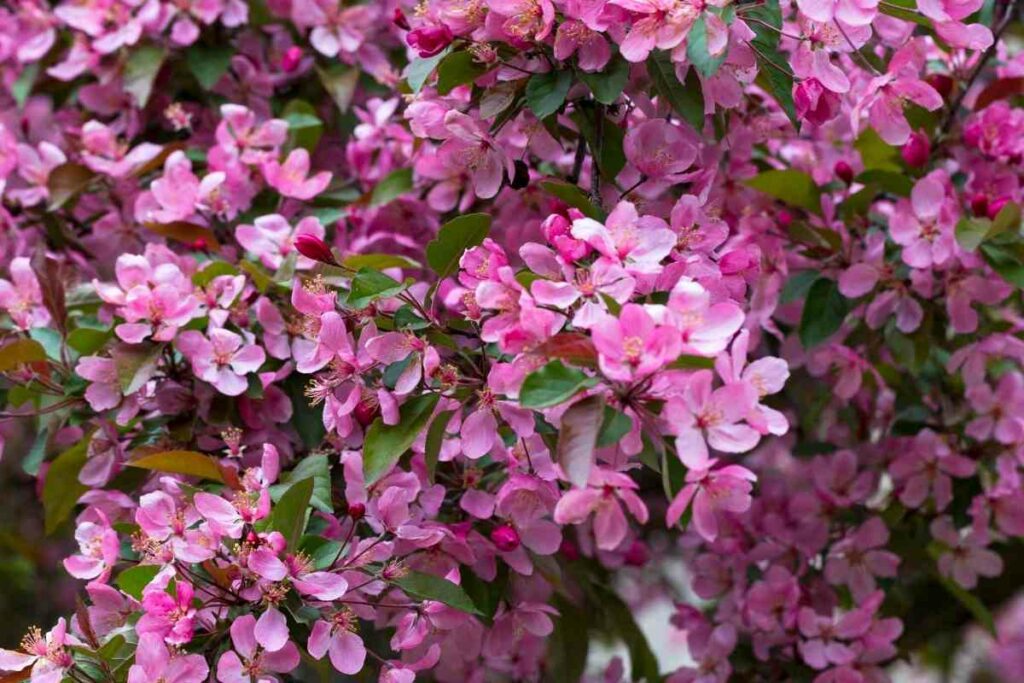
Not only the same amount of petals, but the same shape of flowers too, and they grow in clusters along the branches just like Japanese cherry blossoms.
The colors of apple tree flowers can range from white to pink to even a light purple.
One thing that sets them apart from Japanese cherry blossoms is that the apple tree flowers are much larger, oftentimes twice the size.
Apple trees are very versatile and can grow in a wide range of soils as long as it drains well. They also do best in full sun but can tolerate partial sun too.
As for Watering – Apple trees like to have moist soil but you don’t want the roots sitting in water. Apple trees can grow in a wide range of zones, but they do best in USDA zones 5-8.
6. Eastern Redbud Trees
As the name suggests, the eastern redbud tree produces flowers that are, well, much more red than a Japanese cherry blossom.
The colors of the flowers range anywhere from magenta to burgundy, but none get as close to the delicate pink of the cherry tree flower.
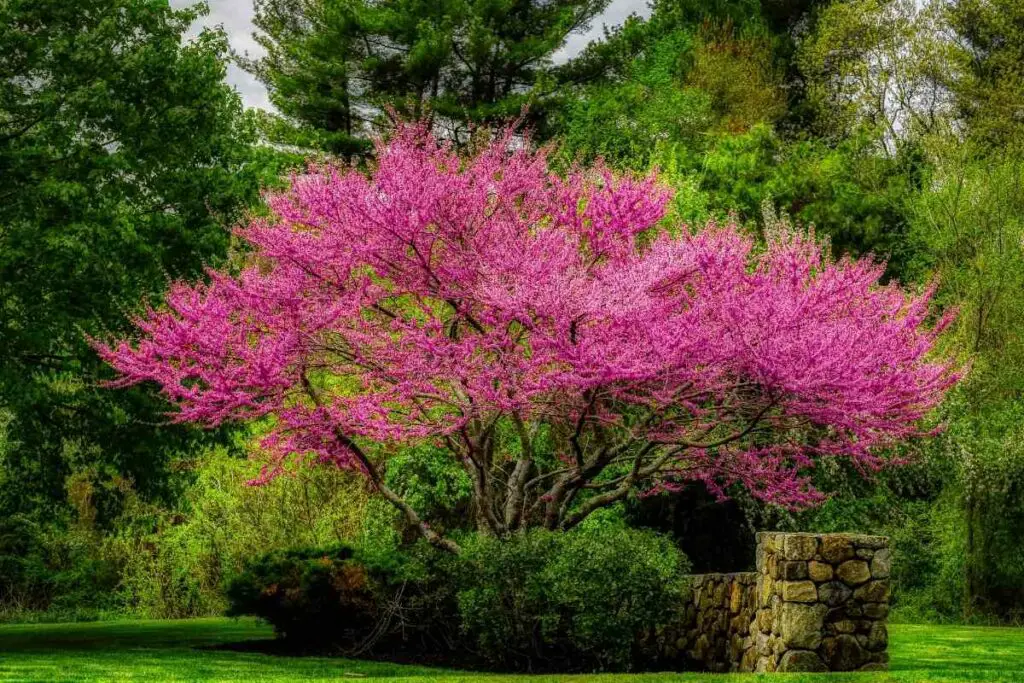
The flowers grow along the entire length of the long branches, making them look like strands of flowers instead of small clusters.
The branches are much more sparse than a Japanese cherry tree too, meaning that although they are covered in flowers, it looks like there’s a lot of empty space on the tree.
With Proper Pruning – And forcing new branches to grow, you can fill in the space and give the tree that cherry tree look that you’re after.
These trees reach 20 to 30 feet tall and up to 35 feet wide when they are grown in USDA zones 5-8.
They thrive mostly on the east coast, but with full sun, plenty of water, and a little bit of fertilizer they can survive just about anywhere.
7. Almond Trees
Similar to the eastern redbud tree, the flowers of the almond tree grow along the length of long branches.
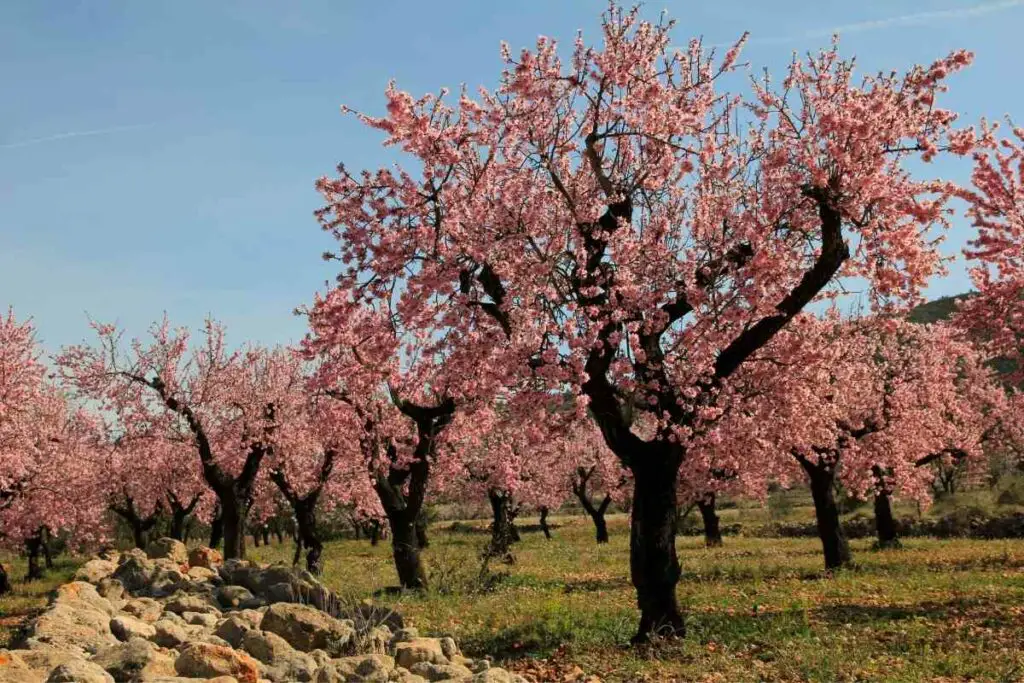
Compared to a Japanese cherry tree, the flowers have quite a few more petals, but they are similar in size, shape, and color.
The almond tree is best suited to USDA zones 6 to 9 and needs full sun, or partial shade and well-drained soil.
They are low-maintenance trees, but be sure to water them regularly during the first few years after planting.
8. Apricot Trees
This is another flowering tree where the flowers completely engulf the branches, but leave empty space between the branches.
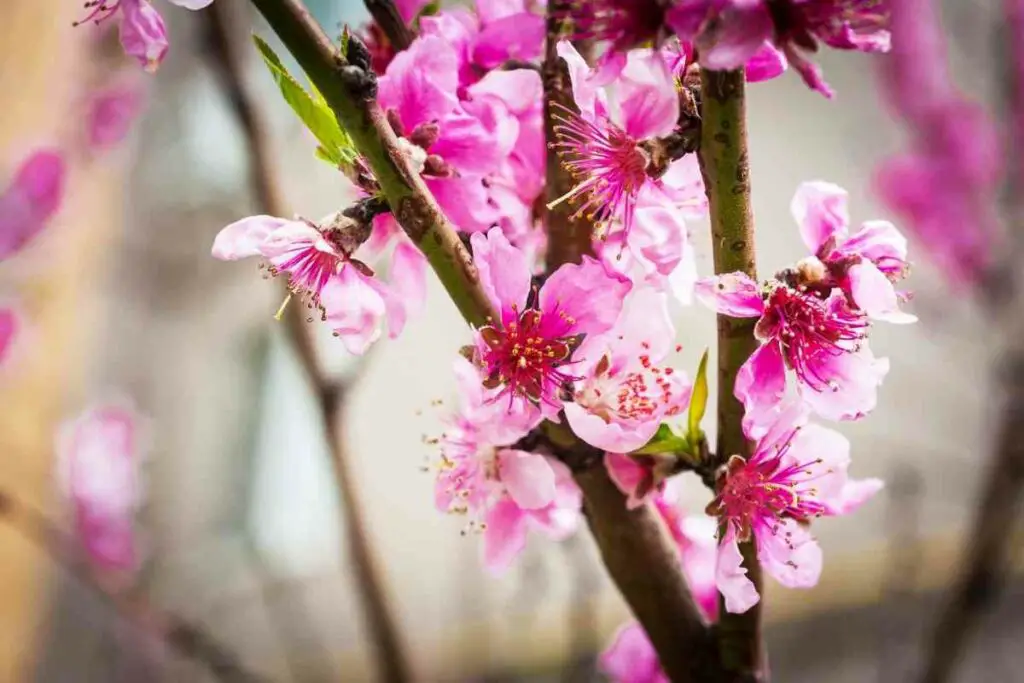
The tree itself looks more like an eastern redbud, but the flowers are very similar to the Japanese cherry tree.
Apricot trees require full sun and well-drained soil. They are hardy in USDA zones 5-8, but if there is a late frost, flowers and fruit won’t develop the following year.
Apricot trees can grow up to 25 feet tall and wide, but they can, and should, be pruned to control their size.
9. Pink Trumpet Trees
The flowers on a pink trumpet tree vary in color from a light pink to a deep magenta, but they tend to stay in the lighter range.
The flowers grow in long clusters and they look very similar to the flowers on a Japanese cherry tree, albeit with more petals.

The leaves of a pink trumpet tree are what give it away as not being a cherry tree.
The leaves are large, heart-shaped, and have a deep green color. The branches are also much thicker than those of a cherry tree.
Pink trumpet trees are hardy in USDA zones 9-11 and need full sun to partial shade and well-drained soil.
They can get up to 40 feet tall and just as wide, so they’re not the best choice if you’re looking for a small tree.
10. Judas Trees
The flowers on a Judas tree are very similar to those of a Japanese cherry blossom, but they have a few key differences:
- Firstly, the Judas tree flowers grow in long clusters, similar to the pink trumpet tree.
- Secondly, the flowers up close are a deep purple color instead of pink or white, but from a distance, they still look like the traditional Japanese cherry blossom.
The leaves of the Judas tree are also much larger than those of a cherry tree. They are an elliptical shape and have a deep green color.

The branches are thick and sturdy, unlike the delicate branches of a cherry tree.
Judas trees are fairly large trees, spreading out to 30 feet wide, and 30 feet tall.
If you need to trim the tree, make sure to do it after the tree flowers to make sure the tree continues to flower the next year.
They are hardy in USDA zones 6-9 and need full sun to partial shade and well-drained soil.
11. Other Types of Cherry Trees
Listing these trees almost feels a little like cheating, so they’re listed near the bottom.
But they still deserve a mention for Japanese cherry tree look-alikes because they do look very similar.
This list of eight cherry trees are all mock cherry trees, which means they flower like the Japanese cherry tree, but they won’t produce any fruit.
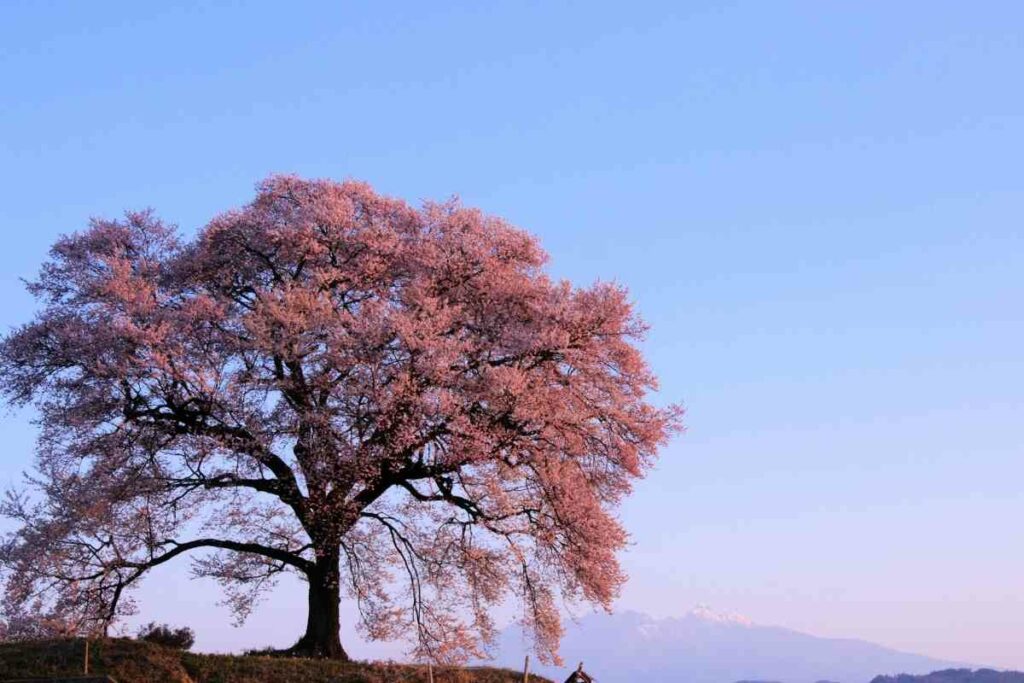
If you don’t enjoy the smell of rotting cherries, or if you don’t want to spend each day picking the cherries up from your yard, these might have a slight advantage.
- Kwanzan Cherry Tree
- Yoshino Cherry Tree
- Akebono Cherry Tree
- Autumn Flowering Cherry Tree
- Fugenzo Cherry Tree
- Okame Cherry Tree
- Weeping Cherry Tree
- Higan Cherry Tree
Final Thoughts
Many different types of trees can be mistaken for a Japanese cherry blossom.
Some have flowers that are a deep purple color and grow in long clusters, while others have flowers that look very similar to the traditional white Japanese cherry blossom.
No matter which type of cherry tree you choose, they all require full sun and well-drained soil.
With the right care, these trees will thrive and provide you with beautiful blossoms each spring.


